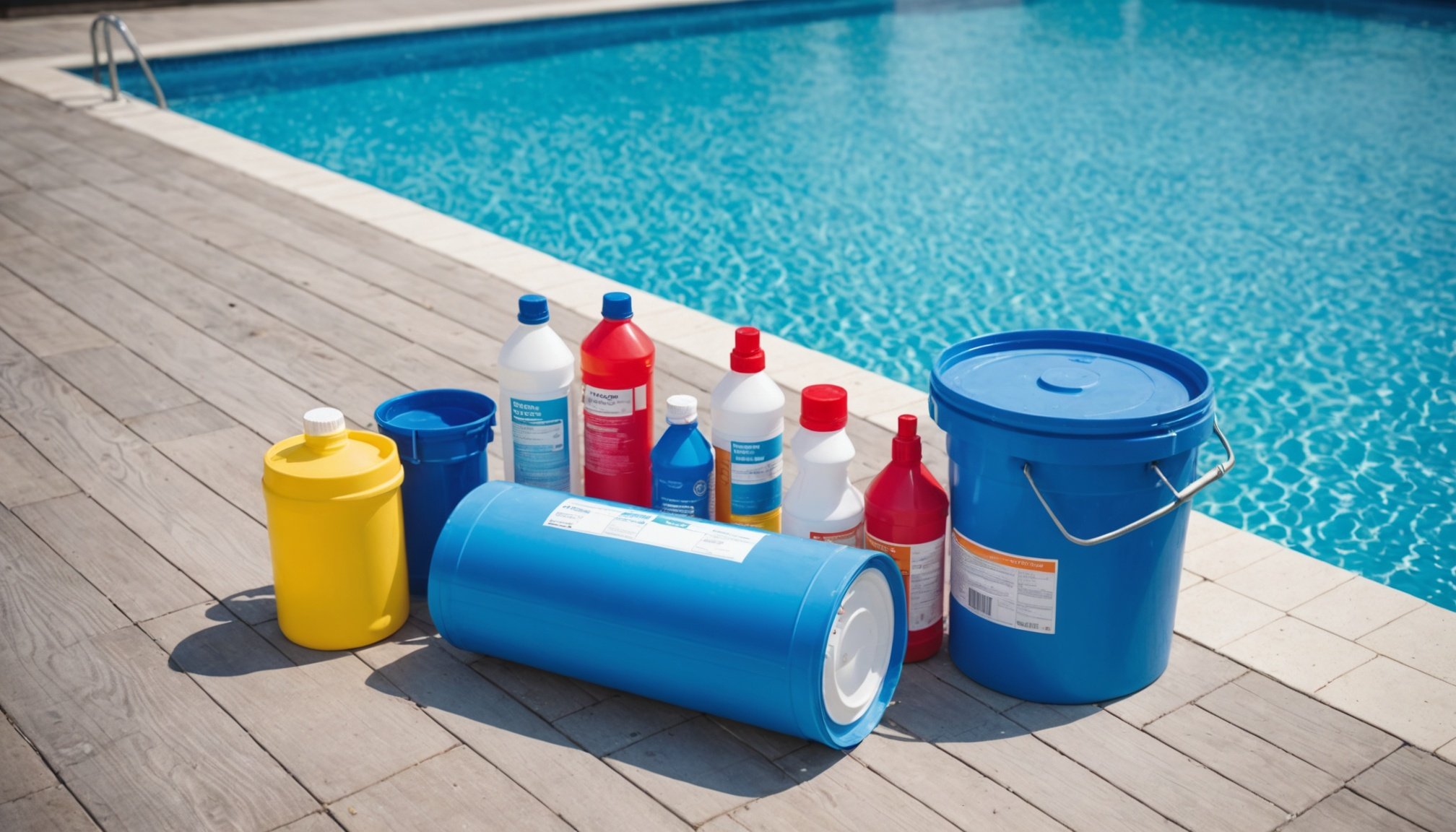Introduction to Safe Pool Chemical Storage
Storing pool chemicals safely is critical to ensure not only the efficient functioning of your pool but also the safety of those near it. Improper storage of these chemicals can lead to significant risks such as chemical reactions, spills, or contamination. Such hazards can potentially cause personal harm and environmental damage, underscoring the necessity of understanding the principles of safe pool chemical storage.
Common risks associated with careless storage include accidental mixing of chemicals like chlorine and acids, which can produce hazardous gases. Additionally, exposure to moisture can lead to chemical degradation, resulting in ineffective solutions or, worse, dangerous byproducts. Ensuring that chemicals are stored correctly, in a cool, dry place, with clearly labelled containers, is paramount in preventing these mishaps.
A découvrir également : Essential Considerations for Choosing the Perfect Pool Slide for Your UK Home
In the UK, specific regulatory guidelines must be adhered to. The Control of Substances Hazardous to Health (COSHH) regulations provide frameworks for handling and storing chemicals safely. Compliance with these regulations not only mitigates risks but also aids in maintaining legal safety standards. By strictly following these guidelines, pool owners can help ensure that their storage practices are aligned with both safety and statutory recommendations, promoting an environment of caution and care.
Legal Requirements for Pool Chemical Storage in the UK
Understanding the legal regulations surrounding the storage of pool chemicals is crucial for pool owners and operators in the UK. Legislation such as the Control of Substances Hazardous to Health (COSHH) and the Health and Safety at Work Act play significant roles in ensuring proper chemical management. Adhering to these laws helps prevent potential hazards and ensures the safety of both pool users and staff.
A découvrir également : Choosing the Ideal Pool Cover for UK Climates: Key Factors You Need to Know
Key Responsibilities
Pool operators must ensure that chemicals are stored in compliance with legal regulations. This includes providing adequate ventilation in storage areas, maintaining clear labels on all chemicals, and ensuring that incompatible substances are stored separately. Owners must also regularly review risk assessments and provide staff with appropriate training to manage chemicals safely.
Consequences of Non-Compliance
Failing to adhere to these regulations can lead to severe consequences. Legal penalties might include fines or revocation of operating licenses, while the risk of accidents and injuries increases significantly. Non-compliance not only jeopardises user safety but can also damage the reputation of a pool facility.
By thoroughly understanding and implementing these legal requirements, pool operators can foster a safer environment and ensure compliance with UK standards. Prioritising safety and staying informed about changing regulations are essential steps in responsible pool management.
Recommended Storage Practices for Pool Chemicals
When storing pool chemicals, adhering to safety guidelines is essential to ensure both effectiveness and safety.
Suitable Storage Locations
Choosing the correct storage location is vital. Pool chemical storage can be handled indoors or outdoors, but it’s crucial to consider the climate. Indoor storage offers a stable environment, protecting chemicals from harsh weather. However, outdoor storage may be preferred to avoid strong chemical odours indoors. Whichever option you choose, ensure that the area is dry and not exposed to extreme temperatures.
Accessibility and security are also important. Chemicals should be stored in a secure area, inaccessible to children and pets, yet easy to reach for those authorised to handle them. Robust locks and warning signs are practical additions.
Ideal Storage Containers
Proper containers are crucial in maintaining chemical integrity. Select containers made from non-reactive materials such as plastic or rubber, as these are less likely to degrade or react with the chemicals. Ensure containers are sealed tightly to prevent leaks and evaporation. Labels and safety data sheets should always be prominently displayed to provide important safety and handling information.
Ventilation and Safety Measures
Adequate ventilation is necessary, especially if choosing indoor storage. It helps disperse harmful fumes, reducing the risk of inhalation. Fire safety measures, such as installing smoke detectors and having fire extinguishers nearby, are vital. Emergency equipment, including eyewash stations and first aid kits, should be readily available. Consider all these aspects for comprehensive pool chemical storage practices.
Identifying Potential Hazards and Safety Protocols
In environments where chemical hazards are pervasive, understanding their potential effects is paramount. Chemicals like ammonia, asbestos, and benzenes are not only health risks but also potential catalysts for hazardous incidents. Exposure to such substances can lead to significant health complications, including respiratory issues, skin irritation, and even long-term diseases. Thus, identifying these hazards promptly is crucial.
To mitigate risks, workplaces should enforce strict safety protocols. These protocols often start with the use of comprehensive personal protective equipment (PPE). PPE such as gloves, goggles, and respiratory masks provide a physical barrier against harmful substances, significantly reducing exposure and risk.
Furthermore, it’s essential to have robust emergency procedures. In the event of accidental exposure or spills, prompt action can prevent injuries and minimise damage. Emergency response training for all staff includes understanding first aid techniques, evacuation routes, and communication procedures with emergency services. This training ensures everyone is prepared to act decisively, limiting harm during unforeseen incidents.
Finally, regular reviews of safety protocols and PPE effectiveness, coupled with continuous training on emergency procedures, cultivate a culture of safety. This proactive approach not only protects individuals but also promotes organisational safety at every level.
Environmental Considerations in Chemical Storage
When it comes to storing chemicals, particularly pool chemicals, understanding and adhering to environmental guidelines is essential. These guidelines are designed to minimise environmental impact and keep communities safe.
One crucial aspect is the proper disposal of chemicals. Improper disposal can lead to environmental hazards, so it’s vital to follow recommended procedures. This includes consulting with local waste management authorities who provide guidelines for the safe disposal of hazardous materials, ensuring that chemicals do not contaminate water supplies or soil.
Environmental regulations play a significant role in chemical storage and disposal. These regulations are set to manage the impact of chemical waste. Companies and individuals must stay compliant with these policies to avoid potential fines and lessen their ecological footprint. Awareness of these rules helps in making informed decisions about storage requirements, labelling, and handling of chemicals.
In addition to understanding regulations, employing best practices in storage can mitigate adverse environmental impacts. For example, storing chemicals in well-ventilated areas and using containment systems to prevent leaks are recommended strategies. Ultimately, responsible management of chemicals not only supports a sustainable environment but also aids compliance with legal standards.
Case Studies and Real-life Examples
Examining real-life cases of pool chemical mishaps highlights the critical nature of proper handling and storage. These real-life cases reveal that improper storage can lead to unexpected and dangerous situations. One notable incident involved pool chemicals stored in a damp garage. This caused a reaction resulting in hazardous fumes, driving home the importance of storing chemicals in a clean, dry area.
From these unfortunate events, several lessons have emerged. Primarily, understanding the risks associated with various pool chemicals aids in averting disasters. Additionally, following manufacturers’ instructions on storage and handling can prevent negative outcomes.
Best practices are often illuminated by case studies, offering valuable insights. A case in point involves a facility where staff underwent thorough training on pool chemical safety. This reduced incidents significantly as workers were more vigilant about ensuring chemicals were consistently sealed and secured.
To mitigate risks, consider these storage examples:
- Store chemicals away from direct sunlight and moisture.
- Use original containers with labels intact.
- Ensure a specific, ventilated area for pool chemical storage.
By prioritising pool chemical safety and heeding lessons learned from real-life cases, potential hazards are significantly reduced, promoting a safer environment for all involved.
Frequently Asked Questions about Pool Chemical Storage
When it comes to pool chemical storage, there are numerous FAQs shedding light on safety concerns. Understanding these elements ensures both safe use and maintenance of your pool environment.
Common Myths and Misconceptions
There are a variety of myths surrounding pool chemical storage. A notable misconception is that storing chemicals in their original containers suffices for safety. While original containers are designed for storage, it’s crucial they are kept in a cool, dry place away from sunlight and incompatible substances. Another myth is that all chemicals have the same storage requirements; however, storage varies significantly between types, requiring thorough label reading and adherence to recommendations.
Addressing Concerns from Pool Owners
Pool owners often express concerns regarding safe storage practices for chemicals on a budget. Common queries include whether it’s safe to store all chemicals together. It’s essential to store incompatible chemicals separately to prevent dangerous reactions. Prioritising safety without overspending involves utilising existing household storage solutions like shelving and ensuring proper ventilation.
Resources for Further Information
Staying informed about chemical storage is essential. Organizations like the EPA offer guidelines on safe chemical practices. Additionally, many pool maintenance websites and forums provide updates on regulatory changes and safety tips, enabling pool owners to maintain a safe and compliant pool environment.











